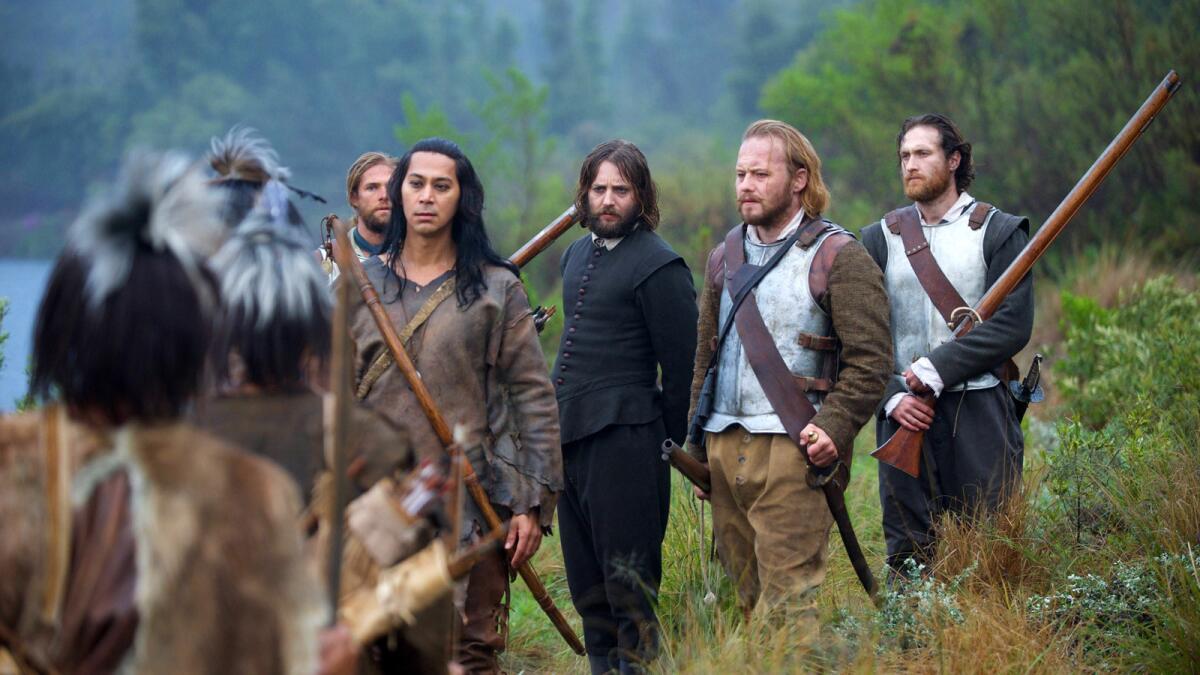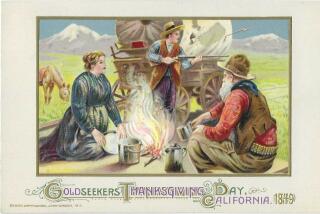Review: ‘Saints & Strangers’ and ‘Pilgrims’ make clear Thanksgiving’s thorny origins

A scene from “Saints & Strangers.”
- Share via
Depending on your viewpoint, it is either fitting or ironic that a heightened debate over various immigration issues should occur in the U.S. during the month of November.
The United States proudly defines itself as a nation of immigrants, and nothing makes this more clear than our affection for the story of Thanksgiving. Fleeing a repressive religious state, a small group of refugees relocated to what is now Massachusetts, where, with the aid of friendly natives, they fought the odds (and non-friendly natives) to plant the seeds of this great nation.
This year, two television specials — “Saints & Strangers,” a two-part drama on National Geographic Channel, and “The Pilgrims,” a PBS documentary by Ric Burns — attempt to tell the tale with a bit more depth and nuance. (The NatGeo show begins airing Sunday, and the PBS program premieres Tuesday.)
SIGN UP for the free Indie Focus movies newsletter >>
Under the leadership of William Bradford, played by the late Roger Rees in “The Pilgrims” and “Mad Men’s” Vincent Kartheiser in “Saints,” the Puritans who boarded the Mayflower with a group of sailors and asylum seekers called themselves pilgrims, but they were in fact, as each film makes clear, just early immigrants.
The wide assortment of Native American tribes living along the northeastern coast of what would be called America had many mixed emotions about the newcomers with their pale skin, odd clothes and history of infectious disease. By the time the Mayflower landed, the local native population had been decimated by a plague transmitted by European fishermen.
The United States proudly defines itself as a nation of immigrants, and nothing makes this more clear than our affection for the story of Thanksgiving.
— Mary McNamara, Los Angeles Times Television Critic
The real miracle of Thanksgiving, then, is that the tribes didn’t unite to slaughter the pilgrims the moment they set foot on the beach.
Some tried, of course. The pilgrims, who had such little knowledge of — or concern about — the European-born plague that they established their settlement on the site of a ravaged village, saw the initial attack simply as confirmation that the natives were “savages.”
Both “Saints & Strangers” and “The Pilgrims” attempt to correct this notion, along with a few other things including the importance of the actual feast (spoiler: no big deal) and, more important, tell the story from multiple points of view.

And though neither are particularly notable examples of their genre, they are welcome additions, and perhaps antidotes, to a historic holiday increasingly driven by gluttony and football. Used as companion pieces, they should make excellent viewing for families able to persuade their children to watch historic dramas and/or documentaries.
With the benefit of more time and literary license, “Saints” is better able to portray the horrific suffering of the settlers, who are beset by hunger, disease and despair both on and then off the Mayflower, while also giving voice to the actual “first” Americans.
Among the first things the pilgrims do upon landing is take corn they find buried at what they thought was an abandoned village and dig up two graves. Already concerned about potential disease, several already fractious tribes meet to make plans. Massasoit (Raoul Trujillo), chief of the Wampanoag, at first favors attack but then eventually realizes an alliance with the settlers could strengthen his tribes’ position in the local hierarchy.
While Bradford attempts to control the more violent element of his settlement, Squanto (Kalani Queypo) provides a bridge between the two groups. Having been enslaved and taken to England, Squanto returned home only to find his village devastated by plague — he is its only survivor. Still, he uses his knowledge of English to broker peace and keep an eye on the settlers.
Allowed to speak in an approximation of the native tongue of the time, Massasoit and the other tribal leaders play a bigger part of this story than more traditional versions, but still the emphasis is on the fortitude of the settlers and their near-impossible undertaking.
But to depict Bradford and his people in a way that is both historically accurate and resonates with modern audiences is also nearly impossible. As the many historians and writers interviewed for “The Pilgrims” repeatedly point out, the Puritans were what many modern Americans would consider religious zealots.
They believed they were a chosen people, that their immigration was the literal will of God. Even the plague was seen as occurring for their personal benefit, to make room for them in the New World.
It is difficult for the modern mind to accept two such apparently opposing viewpoints — the pilgrims were good and brave, the pilgrims viewed Native Americans as inherently inferior if not inhuman — and even more difficult to depict on-screen.
“The Pilgrims” deals with it by allowing its historians to talk too much, “Saints & Strangers” by having its characters talk too little. And while Kartheiser is a solid enough Bradford, Rees, who died in July, does far more with his far fewer minutes.
In both films, the imagery is by far the strongest element. There are so many obvious reasons the Plymouth settlement should have not survived. And yet it did — for reasons, numerous and complicated, and ones that we are only now willing to talk about and try to understand.
-------------------
‘Saints & Strangers: Part One’
Where: NGC
When: Part One, 9 p.m. Sunday; Part Two: 9 p.m. Monday
Rating: TV-14-LV (may be unsuitable for children under the age of 14 with advisories for coarse language and violence)
ALSO:
Five beer brewers tell you which beers to bring to Thanksgiving
Restaurant critic Jonathan Gold shares his secrets to the perfect Thanksgiving stuffing
Why more of your favorite stores are closing on Thanksgiving
More to Read
The complete guide to home viewing
Get Screen Gab for everything about the TV shows and streaming movies everyone’s talking about.
You may occasionally receive promotional content from the Los Angeles Times.







